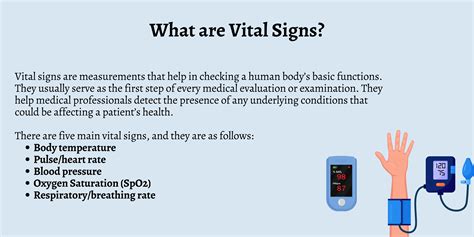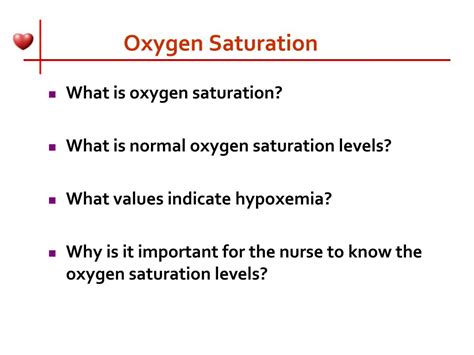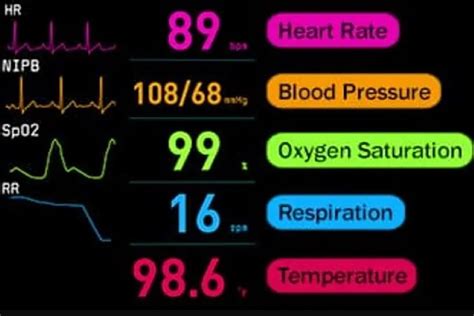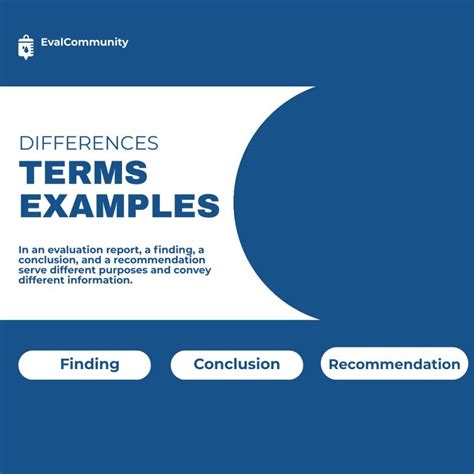Intro
Monitor your health with the 5 Vital Signs, including body temperature, pulse, breathing rate, blood pressure, and oxygen saturation, to detect early warning signs of illness and track overall wellness, ensuring timely medical intervention and preventive care.
Monitoring and understanding the 5 vital signs is crucial for assessing a person's overall health and well-being. These signs are essential indicators that healthcare professionals use to evaluate the body's basic functions and identify potential health issues. The 5 vital signs are temperature, pulse, breathing rate, blood pressure, and oxygen saturation. Each of these signs provides valuable information about the body's condition, and together, they offer a comprehensive picture of a person's health status.
The importance of monitoring the 5 vital signs cannot be overstated. By tracking these signs, healthcare professionals can quickly identify any abnormalities or changes in a person's condition, allowing for prompt interventions and treatments. This is particularly critical in emergency situations, where timely and accurate assessments can be the difference between life and death. Moreover, monitoring the 5 vital signs is also essential for preventing and managing chronic diseases, such as diabetes, heart disease, and respiratory conditions.
In addition to their role in healthcare, the 5 vital signs are also important for individuals to understand and monitor their own health. By being aware of their normal vital sign ranges and any changes that may occur, individuals can take proactive steps to maintain their health and seek medical attention if necessary. This is especially important for people with pre-existing medical conditions, who may need to closely monitor their vital signs to manage their condition effectively. With the advancement of technology, it is now easier than ever for individuals to track their vital signs using wearable devices, mobile apps, and other digital tools.
Introduction to the 5 Vital Signs

Temperature
Temperature is the first of the 5 vital signs and is a critical indicator of the body's overall health. Normal body temperature ranges from 97.7°F to 99.5°F (36.5°C to 37.5°C). An elevated body temperature can indicate the presence of an infection, inflammation, or other underlying medical condition. Conversely, a low body temperature can be a sign of hypothermia, shock, or other serious health issues.Understanding Pulse and Breathing Rate

Blood Pressure
Blood pressure is another essential vital sign that provides information about the body's cardiovascular system. Normal blood pressure ranges from 90/60 mmHg to 120/80 mmHg. Elevated blood pressure can indicate the presence of hypertension, which is a major risk factor for heart disease, stroke, and kidney disease. Conversely, low blood pressure can be a sign of hypotension, shock, or other serious health issues.The Importance of Oxygen Saturation

Monitoring Vital Signs in Different Settings
Monitoring vital signs is essential in various healthcare settings, including hospitals, clinics, and nursing homes. Healthcare professionals use a range of equipment, including thermometers, stethoscopes, blood pressure monitors, and pulse oximeters, to measure vital signs. In addition to these settings, individuals can also monitor their vital signs at home using wearable devices, mobile apps, and other digital tools.Benefits of Monitoring Vital Signs

Common Methods for Monitoring Vital Signs
There are several methods for monitoring vital signs, including manual measurement, automated measurement, and continuous monitoring. Manual measurement involves using equipment, such as thermometers and stethoscopes, to measure vital signs. Automated measurement involves using devices, such as blood pressure monitors and pulse oximeters, to measure vital signs. Continuous monitoring involves using wearable devices and mobile apps to track vital signs in real-time.Challenges and Limitations of Monitoring Vital Signs

Future Directions for Monitoring Vital Signs
The future of monitoring vital signs is exciting, with advances in technology and innovation offering new opportunities for improving healthcare outcomes. Wearable devices, mobile apps, and artificial intelligence are just a few examples of the emerging technologies that are transforming the way we monitor vital signs. As these technologies continue to evolve, we can expect to see improved accuracy, increased accessibility, and enhanced patient engagement.Conclusion and Recommendations

What are the 5 vital signs?
+The 5 vital signs are temperature, pulse, breathing rate, blood pressure, and oxygen saturation.
Why is it important to monitor vital signs?
+Monitoring vital signs is essential for assessing a person's overall health and well-being, and for identifying potential health issues early on.
How can I monitor my vital signs at home?
+You can monitor your vital signs at home using wearable devices, mobile apps, and other digital tools. It's also important to consult with your healthcare professional for guidance on how to measure your vital signs accurately.
We invite you to share your thoughts and experiences with monitoring vital signs. Have you used wearable devices or mobile apps to track your vital signs? What challenges or benefits have you encountered? Please comment below and join the conversation. Additionally, if you found this article informative and helpful, please share it with your friends and family to help spread awareness about the importance of monitoring vital signs.
